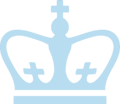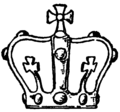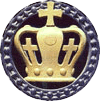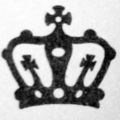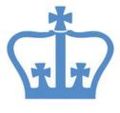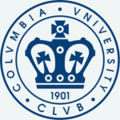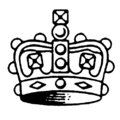Difference between revisions of "Talk:King's Crown (symbol)"
Absentminded (talk | contribs) |
Absentminded (talk | contribs) |
||
| Line 14: | Line 14: | ||
As a side note, the King's College Crown does not appear to correspond exactly with any of the present Crown Jewels of the United Kingdom. The closest match would be [http://www.royal.gov.uk/output/Page5165.asp?GalleryID=15&ImageID=227&Start=0 St. Edward's Crown], which would make sense since, as it was crafted in 1661 and would have been worn by [[King George II|George II]] at the time of the founding of [[King's College]]. However, the Columbia crown is notably missing the [[w:fleur de lis|fleur de lis]] present in all British royal insignia since the [[w:Norman conquest|Norman conquest]]. | As a side note, the King's College Crown does not appear to correspond exactly with any of the present Crown Jewels of the United Kingdom. The closest match would be [http://www.royal.gov.uk/output/Page5165.asp?GalleryID=15&ImageID=227&Start=0 St. Edward's Crown], which would make sense since, as it was crafted in 1661 and would have been worn by [[King George II|George II]] at the time of the founding of [[King's College]]. However, the Columbia crown is notably missing the [[w:fleur de lis|fleur de lis]] present in all British royal insignia since the [[w:Norman conquest|Norman conquest]]. | ||
| − | It's interesting to note that despite serving as the inspiration for the various crown designs, many of the designs, including the earliest, depart in a variety of ways from the original | + | It's interesting to note that despite serving as the inspiration for the various crown designs, many of the designs, including the earliest, depart in a variety of ways from the original. |
<gallery> | <gallery> | ||
| Line 22: | Line 22: | ||
==Adoption as a symbol== | ==Adoption as a symbol== | ||
| + | [[Image:1912crown.png|thumb|120px|The crown logo of the Kings Crown society]] | ||
Unlike the [[Columbia Lion|lion]], or the [[University Shield|shield]], the crown was not adopted with official fanfare and rollout, but rather grew organically to become part of the University's iconography. This may explain in part the myriad designs, proliferation of variants, and lack of a cohesive set of crown symbols for a long period of time. | Unlike the [[Columbia Lion|lion]], or the [[University Shield|shield]], the crown was not adopted with official fanfare and rollout, but rather grew organically to become part of the University's iconography. This may explain in part the myriad designs, proliferation of variants, and lack of a cohesive set of crown symbols for a long period of time. | ||
Nevertheless, there are three events that, perhaps, had the most to do with the crown's staying power. The first was student driven, and the second, alumni. | Nevertheless, there are three events that, perhaps, had the most to do with the crown's staying power. The first was student driven, and the second, alumni. | ||
| − | + | In November 1898, a group of students and professors founded a new student literary society, [[King's Crown (group)|"Kings Crown"]]. From the beginning, the groups organizers had grander plans for the organization, envisioning a general social club for college students. The group engaged in planning social and school spirit events, even the Varsity Show for a period of time, and eventually became the governing body of all non-athletic activities on campus. Their stated goal was to promote the 'collegiate spirit' on campus, and they deliberately steeped themselves in tradition and history, reaching back to old King's College and prominently featured a crown in their logo, designed by School of Architecture student Huger Elliott (Class of 1899.) This crown might arguably said to be the forefather of all our crown designs today. | |
| − | It should be noted that this design introduced a number of major design departures from the original King's College Crown - the elongated crosses, the lack of a ball between the crown and cross on top, and the removal of alternating diamond-shaped decorations around the | + | It should be noted that this design introduced a number of major design departures from the original King's College Crown - the elongated crosses, the lack of a ball (the [[w:Monde (crown)|monde]]) between the crown and cross on top, and the removal of alternating diamond-shaped decorations around the band. In the original design the crosses attached to the band are very short, leaving much of the space above "empty." In this design, and subsequent designs based on it, the crosses are stretched to 'fill out' the space. |
| − | In May 1906, the Class of 1881 made a 25th anniversary gift that would ensure that the crown became a visible fixture on campus, donating the flagpole east of [[Low Library]]'s entrance to fly the Kings Crown logo.<ref>Sources conflict. The Spectator reports that the flagstaff was to be used exclusively for the student organization Kings Crown. The Columbia Alumni News, on the other hand, says its for the "University Flag."</ref> The pole itself is topped by a crown, much in the way that the old [[College Hall]] was topped with the original King's Crown. This crown adds | + | [[Image:FlagpoleCrown.jpg|thumb|120px|The crown atop the Class of 1881 [[Flagpole]] in front of Low Library]]In May 1906, the Class of 1881 made a 25th anniversary gift that would ensure that the crown became a visible fixture on campus, donating the flagpole east of [[Low Library]]'s entrance to fly the Kings Crown logo.<ref>Sources conflict. The Spectator reports that the flagstaff was to be used exclusively for the student organization Kings Crown. The Columbia Alumni News, on the other hand, says its for the "University Flag."</ref> The pole itself is topped by a crown, much in the way that the old [[College Hall]] was topped with the original King's Crown. This crown adds two additional design difference from the original King's Crown - the [[w:Half-arch (crown)|half-arches]] are not of even width, but are curved, and the crosses inside the crown are [[w:Christian crosslatin crosses]], rather than [[w:Cross pattée|crosses pattée]]. The undulating half-arches have remained in all of the current designs. It's unclear which exact design was featured on the original flag, but it's likely the crown from the Kings Crown logo. |
Finally, in 1913, Kings Crown was converted into an umbrella organization to officially oversee all non-athletic student organizations. It seems that at this period Kings Crown effectively became the predecessor to today's [[Activities Board at Columbia]] (ABC). As a result, the Kings Crown logo became a fixture in student life, affixed to the cover of handbooks and guidelines etc. | Finally, in 1913, Kings Crown was converted into an umbrella organization to officially oversee all non-athletic student organizations. It seems that at this period Kings Crown effectively became the predecessor to today's [[Activities Board at Columbia]] (ABC). As a result, the Kings Crown logo became a fixture in student life, affixed to the cover of handbooks and guidelines etc. | ||
| Line 41: | Line 42: | ||
A survey of the campus to see when and where the crown appears (and in what forms) is interesting. The earliest buildings on campus (Low Library, Schermerhorn, Havemeyer, Fayerweather, and Mathetmatics (then the school of mines) Halls) feature no crown iconography in their design.<ref>Curiously, at about the same time that Kings Crown came into existence, the trustees had a plaque installed at the site of [[College Hall]] which also featured a crown, despite not incorporating the crown into any of the new buildings.</ref> | A survey of the campus to see when and where the crown appears (and in what forms) is interesting. The earliest buildings on campus (Low Library, Schermerhorn, Havemeyer, Fayerweather, and Mathetmatics (then the school of mines) Halls) feature no crown iconography in their design.<ref>Curiously, at about the same time that Kings Crown came into existence, the trustees had a plaque installed at the site of [[College Hall]] which also featured a crown, despite not incorporating the crown into any of the new buildings.</ref> | ||
| − | The first architectural incorporation of the crown came with Alma Mater (dedicated in 1903) - a crown that closely resembles the original King's College crown tops her scepter, and a two-dimensional image of the crown is incorporated into a relief of the [[University Shield]] on the back of her chair. | + | [[Image:AlmaBackCrown.jpg|thumb|120px|The crown stamped on the back of Alma Mater, the oldest appearance of the Crown on campus]]The first architectural incorporation of the crown came with Alma Mater (dedicated in 1903) - a crown that closely resembles the original King's College crown tops her scepter, and a two-dimensional image of the crown is incorporated into a relief of the [[University Shield]] on the back of her chair. |
| − | Hamilton Hall, constructed between 1905-1907, features crowns in stone right above the carvings of the school seals above each door (similar to many of the McKim Meade and White buildings around [[South Field]] also have), and as part of the decorative frieze in the lobby. Subsequent to the construction of the building, a few graduating classes planted ivy outside the hall, and marked the spot with a carved crown in the foundation. All three crown designs feature elongated crosses. A somewhat different looking crown appears on the door of the Dean's office and is based on the carving directly above it, which was donated as a 25th anniversary gift by the class of 1894. That crown design appears throughout Hamilton Hall on plaques recognizing donors for the most recent renovation of the building, constituting the sole use of the design on campus. | + | [[Image:HamiltonCrown.jpg|thumb|120px|Crown on the frieze in Hamilton Hall]]Hamilton Hall, constructed between 1905-1907, features crowns in stone right above the carvings of the school seals above each door (similar to many of the McKim Meade and White buildings around [[South Field]] also have), and as part of the decorative frieze in the lobby. Subsequent to the construction of the building, a few graduating classes planted ivy outside the hall, and marked the spot with a carved crown in the foundation. All three crown designs feature elongated crosses. A somewhat different looking crown appears on the door of the Dean's office and is based on the carving directly above it, which was donated as a 25th anniversary gift by the class of 1894. That crown design appears throughout Hamilton Hall on plaques recognizing donors for the most recent renovation of the building, constituting the sole use of the design on campus. |
The crown also makes brief appearances on two other buildings - high up on the facade of [[Avery Hall]] (built in 1912), and above the door of Wien Hall (built in 1925 as Johnson Hall). | The crown also makes brief appearances on two other buildings - high up on the facade of [[Avery Hall]] (built in 1912), and above the door of Wien Hall (built in 1925 as Johnson Hall). | ||
| − | Perhaps the most extensive use of the original King's College crown design occurs inside Butler Library (built 1931-1934). Upon entering, a visitor stands between two beautiful gates leading into the library on the left and right. Each gate is topped by a crown similar to the original design. Within Butler, the same crown design appears in the molding running along the ceiling of Butler Lounge, and the Reading Room (Butler 209). | + | [[Image:ButlerFrieze.jpg|thumb|120px|Crown on the molding in Butler Lounge]]Perhaps the most extensive use of the original King's College crown design occurs inside Butler Library (built 1931-1934). Upon entering, a visitor stands between two beautiful gates leading into the library on the left and right. Each gate is topped by a crown similar to the original design. Within Butler, the same crown design appears in the molding running along the ceiling of Butler Lounge, and the Reading Room (Butler 209). |
A more recent architectural employment of the crown is atop the 116th Street gates on Broadway and Amsterdam Ave (installed in 1970). | A more recent architectural employment of the crown is atop the 116th Street gates on Broadway and Amsterdam Ave (installed in 1970). | ||
| + | |||
| + | <gallery> | ||
| + | Image:AlmaCrown.jpg|The crown atop Alma Mater's Sceptre | ||
| + | Image:GateCrown.jpg|The crown atop the 116th Street Gates, based on the flagpole crown | ||
| + | Image:1911ivycrown.jpg|A crown carved into the foundation of [[Hamilton Hall]] | ||
| + | Image:GoldCrown.gif|A design based on the KC crown used on the rarely seen [[Hamilton Hall]] gates | ||
| + | Image:ccdeancrown1.jpg|Crown above the [[CC]] Dean's office door. It's also affixed to various plaques and doors in [[Hamilton Hall]]. | ||
| + | Image:ccdeancrown.jpg|Crown on the [[CC]] Dean's office door | ||
| + | Image:ButlerGate.jpg|Crown affixed above the decorative gates in the lobby of Butler Library | ||
| + | </gallery | ||
==Designs== | ==Designs== | ||
| Line 65: | Line 76: | ||
While the design of the Columbia College Crown has been around for nearly a century, it was not given an official digitization treatment until 2007 when a member of CCIT on his own initiative undertook an effort to produce a definitive sample of the design to replace the various low-quality graphics that were in use. | While the design of the Columbia College Crown has been around for nearly a century, it was not given an official digitization treatment until 2007 when a member of CCIT on his own initiative undertook an effort to produce a definitive sample of the design to replace the various low-quality graphics that were in use. | ||
| − | + | ||
| − | === | + | <gallery> |
| + | Image:CCSketchCrown1910.jpg|A drawing of a crown on the cover of a Spring 1910 issue of Columbia Alumni News | ||
| + | Image:CCCrown1910.jpg|The Columbia College Crown as it appeared on the cover of the Columbia Alumni News in Fall 1910 | ||
| + | </gallery> | ||
| + | |||
| + | ===Modern Crown=== | ||
===Columbia University Press Crown=== | ===Columbia University Press Crown=== | ||
| + | [[Image:OldCrown.jpg|120px|thumb|Post-war Crown Design]] | ||
| + | In 1946 Columbia University Press updated it's logo with a clean modern crown logo.<ref>This date is approximated from when the earliest book I could find with the logo, and the date on Columbia's application for a trademark of the design with the Patent and Trademark Office.</ref> Over time this logo would be adopted, probably unofficially, by various divisions of the University. | ||
| + | |||
| + | This design is not particularly visible around campus anymore in its original form except at [[Teachers College]], which has retained it to this day as its version of the crown logo. It can be seen on the cover pages of Horace Coon's [[Books about Columbia|"Columbia: Colossus on the Hudson]] (1947), the book [[Books about Columbia|"Columbia Remembered"]] (1967), and on the south face of the water tower housing atop the apartment building and offices Columbia built on the corner of Riverside Drive and St. Clair Place (560 Riverside Drive- it's best visible from Riverside Drive going north). However it occasionally shows up unexpectedly in odd places, e.g. the stone marker southwest of the rotunda on [[Van Am Quad]] recognizing the Class of 1952's 35th anniversary gift, and the Class of 2002's [[Class Day]] program.[http://www.college.columbia.edu/photos/classday2002/programcc2002.jpg] | ||
| + | |||
| + | Until the spring of [[2008]] the post-war design's most conspicuous and lasting legacy was its incorporation into the [[SEAS]] crown logo. Since 2008 SEAS has adopted an updated crown, replacing the post-war crown with the current butterfly shaped crown with crosses. | ||
| + | |||
| + | The crown that adorns the lapel of [[graduation robes]] appears to be a close derivative, though not an exact copy, of this particular design, as it's also smooth and unornamented. | ||
| + | |||
| + | It also appears to have been adopted in some form by facilties for a period of time.<ref>See logo on the sign in the picture of Alfred Lerner standing outside a construction trailer during the construction of Lerner Hall</ref>. | ||
| + | |||
| + | <gallery> | ||
| + | Image:SEASCrown.png|[[SEAS]] crown | ||
| + | Image:TCLogo.jpg|Teachers College logo | ||
| + | Image:RobeLapel.jpg|Crown on the lapel of [[Graduation robes]] | ||
| + | Image:Placeholder.jpg|Crown atop 560 Riverside Drive | ||
| + | </gallery> | ||
===Other designs=== | ===Other designs=== | ||
| + | |||
| + | |||
| + | <gallery> | ||
| + | Image:YearbookCrown.jpg|A crown printed on the cover of the yearbook for at least 1959-1963 | ||
| + | Image:ColumbiaClubSeal.gif|The [[Columbia University Club of New York]] seal | ||
| + | Image:ReliefCrown.png|The 'relief' crown, featured on the original [[University Shield]] design | ||
| + | Image:ButlerPainting.jpg|Crown on a banner in Low Library during the the Queen of England's visit to Columbia as depicted on a painting on the 3rd floor in Butler Library | ||
| + | </gallery> | ||
Revision as of 23:55, 18 November 2009
Editor's Note: This article is highly inferential. I've tried to reference sources where possible, but a lot of it is just based on my own observations around campus after fitting a few key pieces of the puzzle together. Absentminded 00:48, 3 February 2008 (EST)
Contents
draft of rewritten article
The King's Crown is a common symbol associated with Columbia. As a symbol, the crown has undergone a number of transformations and adaptations over the years. Recently, the university appears to have adopted the crown as its primary symbolic image, giving it precedence over the seal and shield in branding. Technically speaking, usage of the crown is regulated by the Secretary of the University. Historically it's been slapped on just about everything by everyone without so much as a second thought, but the University appears to be making efforts to regulate the school's visual identity.[1]
The Crown of King's College
Columbia's symbolic association with a crown dates back to the days of King's College, when a copper crown was affixed atop the cupola of College Hall[2], a visible symbol of the College's royal charter. Today, that crown hangs over the fireplace in the Trustees Room of Low Library, above the portrait of Samuel Johnson and the cornerstone of College Hall.
On a visit to New York in 1820, Stratford Canning, a British diplomat and future ambassador to the Ottoman Empire, was shown the crown by Professor John McVickar. Canning reportedly commented "You should preserve that crown carefully, sir, for you republicans will by-and-by need a crown."[3][4]
As a side note, the King's College Crown does not appear to correspond exactly with any of the present Crown Jewels of the United Kingdom. The closest match would be St. Edward's Crown, which would make sense since, as it was crafted in 1661 and would have been worn by George II at the time of the founding of King's College. However, the Columbia crown is notably missing the fleur de lis present in all British royal insignia since the Norman conquest.
It's interesting to note that despite serving as the inspiration for the various crown designs, many of the designs, including the earliest, depart in a variety of ways from the original.
The Crown of King's College, in the Trustees Room of Low Library
A sketch of the crown gracing the copyright page of the 1904 sesquicentennial history of the school, "Columbia University: A History", titled perhaps erroneously, as the "Iron Crown of King's College."
Adoption as a symbol
Unlike the lion, or the shield, the crown was not adopted with official fanfare and rollout, but rather grew organically to become part of the University's iconography. This may explain in part the myriad designs, proliferation of variants, and lack of a cohesive set of crown symbols for a long period of time.
Nevertheless, there are three events that, perhaps, had the most to do with the crown's staying power. The first was student driven, and the second, alumni.
In November 1898, a group of students and professors founded a new student literary society, "Kings Crown". From the beginning, the groups organizers had grander plans for the organization, envisioning a general social club for college students. The group engaged in planning social and school spirit events, even the Varsity Show for a period of time, and eventually became the governing body of all non-athletic activities on campus. Their stated goal was to promote the 'collegiate spirit' on campus, and they deliberately steeped themselves in tradition and history, reaching back to old King's College and prominently featured a crown in their logo, designed by School of Architecture student Huger Elliott (Class of 1899.) This crown might arguably said to be the forefather of all our crown designs today.
It should be noted that this design introduced a number of major design departures from the original King's College Crown - the elongated crosses, the lack of a ball (the monde) between the crown and cross on top, and the removal of alternating diamond-shaped decorations around the band. In the original design the crosses attached to the band are very short, leaving much of the space above "empty." In this design, and subsequent designs based on it, the crosses are stretched to 'fill out' the space.

In May 1906, the Class of 1881 made a 25th anniversary gift that would ensure that the crown became a visible fixture on campus, donating the flagpole east of Low Library's entrance to fly the Kings Crown logo.[5] The pole itself is topped by a crown, much in the way that the old College Hall was topped with the original King's Crown. This crown adds two additional design difference from the original King's Crown - the half-arches are not of even width, but are curved, and the crosses inside the crown are w:Christian crosslatin crosses, rather than crosses pattée. The undulating half-arches have remained in all of the current designs. It's unclear which exact design was featured on the original flag, but it's likely the crown from the Kings Crown logo.
Finally, in 1913, Kings Crown was converted into an umbrella organization to officially oversee all non-athletic student organizations. It seems that at this period Kings Crown effectively became the predecessor to today's Activities Board at Columbia (ABC). As a result, the Kings Crown logo became a fixture in student life, affixed to the cover of handbooks and guidelines etc.
Despite it's long run, the original Kings Crown logo has effectively vanished from use, though many of its design elements are visible in current designs.
One additional interesting note is that even as early as 1912 it was unclear to observers where exactly the crown came from as a symbol. It is noted in An Official Guide to Columbia Univeristy (1912) that the original King's Crown from King's College had served as the inspiration for its adoption as a symbol but no further details are provided.[6]
Crowns around campus
A survey of the campus to see when and where the crown appears (and in what forms) is interesting. The earliest buildings on campus (Low Library, Schermerhorn, Havemeyer, Fayerweather, and Mathetmatics (then the school of mines) Halls) feature no crown iconography in their design.[7]
The first architectural incorporation of the crown came with Alma Mater (dedicated in 1903) - a crown that closely resembles the original King's College crown tops her scepter, and a two-dimensional image of the crown is incorporated into a relief of the University Shield on the back of her chair.
Hamilton Hall, constructed between 1905-1907, features crowns in stone right above the carvings of the school seals above each door (similar to many of the McKim Meade and White buildings around South Field also have), and as part of the decorative frieze in the lobby. Subsequent to the construction of the building, a few graduating classes planted ivy outside the hall, and marked the spot with a carved crown in the foundation. All three crown designs feature elongated crosses. A somewhat different looking crown appears on the door of the Dean's office and is based on the carving directly above it, which was donated as a 25th anniversary gift by the class of 1894. That crown design appears throughout Hamilton Hall on plaques recognizing donors for the most recent renovation of the building, constituting the sole use of the design on campus.
The crown also makes brief appearances on two other buildings - high up on the facade of Avery Hall (built in 1912), and above the door of Wien Hall (built in 1925 as Johnson Hall).
Perhaps the most extensive use of the original King's College crown design occurs inside Butler Library (built 1931-1934). Upon entering, a visitor stands between two beautiful gates leading into the library on the left and right. Each gate is topped by a crown similar to the original design. Within Butler, the same crown design appears in the molding running along the ceiling of Butler Lounge, and the Reading Room (Butler 209).
A more recent architectural employment of the crown is atop the 116th Street gates on Broadway and Amsterdam Ave (installed in 1970).
A crown carved into the foundation of Hamilton Hall
A design based on the KC crown used on the rarely seen Hamilton Hall gates
Crown above the CC Dean's office door. It's also affixed to various plaques and doors in Hamilton Hall.
Crown on the CC Dean's office door
- ==Designs==
- ===Columbia College Crown===
- For the first issue of it's second volume (7 July 1910) the newsletter cleaned up the cover art, but incorporated a crown design into each of the four corners of the border. This crown design is what we know today as the Columbia College Crown.
Modern Crown
Columbia University Press Crown
In 1946 Columbia University Press updated it's logo with a clean modern crown logo.[8] Over time this logo would be adopted, probably unofficially, by various divisions of the University.
This design is not particularly visible around campus anymore in its original form except at Teachers College, which has retained it to this day as its version of the crown logo. It can be seen on the cover pages of Horace Coon's "Columbia: Colossus on the Hudson (1947), the book "Columbia Remembered" (1967), and on the south face of the water tower housing atop the apartment building and offices Columbia built on the corner of Riverside Drive and St. Clair Place (560 Riverside Drive- it's best visible from Riverside Drive going north). However it occasionally shows up unexpectedly in odd places, e.g. the stone marker southwest of the rotunda on Van Am Quad recognizing the Class of 1952's 35th anniversary gift, and the Class of 2002's Class Day program.[1]
Until the spring of 2008 the post-war design's most conspicuous and lasting legacy was its incorporation into the SEAS crown logo. Since 2008 SEAS has adopted an updated crown, replacing the post-war crown with the current butterfly shaped crown with crosses.
The crown that adorns the lapel of graduation robes appears to be a close derivative, though not an exact copy, of this particular design, as it's also smooth and unornamented.
It also appears to have been adopted in some form by facilties for a period of time.[9].
SEAS crown
Crown on the lapel of Graduation robes
- Placeholder.jpg
Crown atop 560 Riverside Drive
Other designs
The Columbia University Club of New York seal
The 'relief' crown, featured on the original University Shield design
- ↑ [http://www.columbia.edu/cu/identityguidelines//blue290.pdf blue290 A Practical Guide to Columbia’s Standards of Visual Identity (May 2009)]
- ↑ Some references suggest that it was part of a weathervane, while others suggest a flagpole
- ↑ Harper's New Monthly Magazine, Volumbia LXIX, June to November, 1884
- ↑ A conflicting, and likely incorrect, source states that the crown, having been removed in the revolutionary era, sat forgotten in a corner gathering dust until rediscovered when the College prepared to move to midtown.
- ↑ Sources conflict. The Spectator reports that the flagstaff was to be used exclusively for the student organization Kings Crown. The Columbia Alumni News, on the other hand, says its for the "University Flag."
- ↑ Pg. 16, An Official Guide to Columbia Univeristy (1912)
- ↑ Curiously, at about the same time that Kings Crown came into existence, the trustees had a plaque installed at the site of College Hall which also featured a crown, despite not incorporating the crown into any of the new buildings.
- ↑ This date is approximated from when the earliest book I could find with the logo, and the date on Columbia's application for a trademark of the design with the Patent and Trademark Office.
- ↑ See logo on the sign in the picture of Alfred Lerner standing outside a construction trailer during the construction of Lerner Hall
